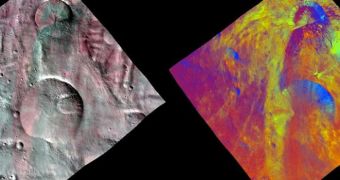Relatively-new craters on the surface of the protoplanet Vesta have been revealed by the NASA Dawn spacecraft. The probe's framing cameras managed to find the structures even if they were partially concealed by a layer of sediments and other debris.
In fact, it would now appear that Vesta – the largest asteroid in our solar system – is in fact covered with a loose layer of material, which it may have accumulated while orbiting through the Inner Asteroid Belt (IAB).
Landslides of such debris, plus sediments from Vesta itself, poured over the fresh crater, covering them up at least partially. Still, Dawn's framing cameras were able to collect this image of the asteroid's south pole on December 6.
The image to the left contains data collected with near-infrared filters, whereas the other one is based on colors that scientists assigned to various types of rocks, dust and other debris.

 14 DAY TRIAL //
14 DAY TRIAL //